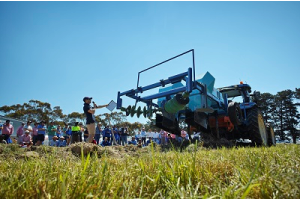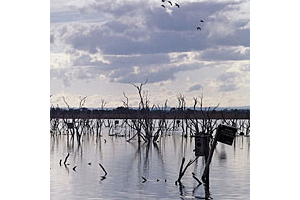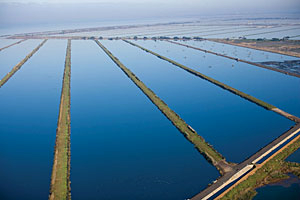The INI2016 conference tours will provide delegates opportunities to learn about nitrogen use and management within the context of a number of industries, both agricultural and urban, in Victoria.
The tours are structured to provide an overview of an industry as well as a broader catchment/value-chain perspective.
Each tour will visit a number of sites a short bus ride from the conference venue.
The tours take delegates through different landscapes giving them an opportunity to see the Victorian countryside and regional areas.
The tours will take place on Tuesday 6th December and are included in the full registration fee. Additional tickets can be purchased for $95.00.
Delegates need to self-select their preferred tour option. We recommend early selection as seats are limited, and tours will close when full. The tours will commence at 8:00am and we expect to return delegates to the conference venue by 5:00pm.
Dr Sharon Aarons
Senior Research Scientist, Agriculture Victoria, Victorian Government
Field Tour Coordinator

Images from INI2016 Field Tours

Delegates from the INI 2016 conference at the AgVic, Ellinbank feed pad complex – learning about research undertaken validating the alkane method for estimating pasture intake. Speaker Marlie Wright PhD student and junior scientist.
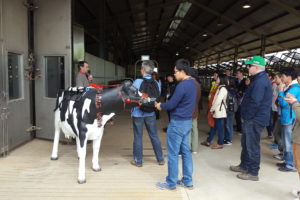
Delegates from the INI 2016 conference at the AgVic, Ellinbank animal nutrition complex – learning about methane emission trials using specialized saddle and halter equipment to sample breath and background air. Speaker Richard Williams and Elli the demo cow.
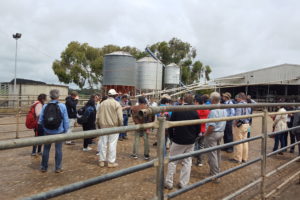
Delegates from the INI 2016 conference at the AgVic, Ellinbank Dairy shed stock yards – learning about the complexities of coordinating farm operations and research requirements during trials on an operational grazing system farm. Speaker Greg Morris dairy manager and senior technical officer.

Delegates from the INI 2016 conference at the AgVic, Ellinbank Dairy shed stock yards – learning about the complexities of coordinating farm operations and research requirements during trials on an operational grazing system farm. Speaker Greg Morris dairy manager and senior technical officer.

Delegates from the INI 2016 conference at AgVic, Ellinbank feed value index field site – learning about nitrous oxide (most potent greenhouse gas) emissions associated with fertilisers, manure applications and water use of irrigated forages. Speaker- Research scientist Kevin Kelly.
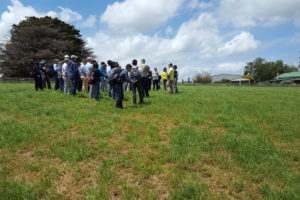
Delegates from the INI 2016 conference viewing and learning about commercial grazing system dairy farms – Speaker Chris Bagot, farm owner; describing his productions system, grazing and pasture management.

Delegates from the INI 2016 conference viewing and learning about commercial grazing system dairy farms – Speaker Chris Bagot, farm owner; describing his productions system, grazing and pasture management.
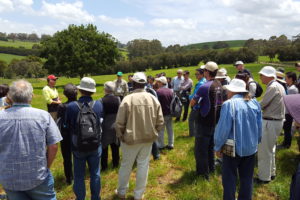
Delegates from the INI 2016 conference viewing and learning about commercial grazing system dairy farms – Speaker Chris Bagot, farm owner; describing his productions system, grazing and pasture management.
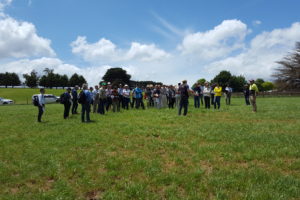
Delegates from the INI 2016 conference viewing and learning about commercial grazing system dairy farms – Speaker Pat Bloye, farm manager describing pasture, herd and soil management.

Delegates from the INI 2016 conference learning about energy efficiency, sustainable energy technologies and how they may best be utilised in the dairy industry – Speaker Gabby Hakim, AgVet projects consultant describing the energy saving technologies installed on Chris Bagot’s farm.
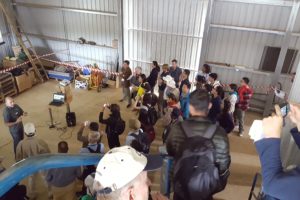
Delegates from the INI 2016 conference learning about energy efficiency, sustainable energy technologies and how they may best be utilised in the dairy industry – Speaker Gabby Hakim, AgVet projects consultant describing the energy saving technologies installed on Chris Bagot’s farm.
Field Tours
- Tour 1 – Grazing based dairy and catchment impacts (East of Melbourne) **Fully Booked**
The dairy industry is the 3rd largest rural industry in Australia and dairy products are the largest Victorian export from the port of Melbourne. Although grazing-based, the industry has intensified with imported feed nutrients contributing on average 40% of dietary intakes.
Delegates will visit the Ellinbank Dairy Centre, Australia’s largest dairy research institute to view animal, soil and pasture research programs, including N management, GHG emissions, feed conversion efficiency and heat tolerance by dairy cows, and effluent management research. The delegates will tour the research facilities to view the animal calorimeters, metabolism stalls and the automated dairy.
After a barbeque lunch, the tour will visit a local grazing based dairy farm where the farmer will describe his operation including how he manages N. The farm is within a catchment that supplies domestic water for Melbourne’s residents. The tour will conclude with descriptions of activities being undertaken to manage the impact of N on waterways.


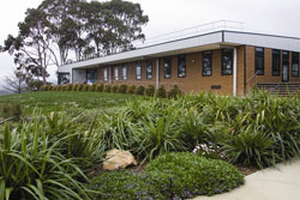
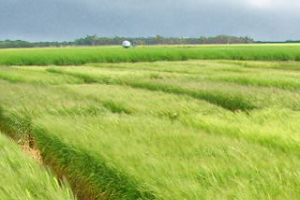



- Tour 2 – Fertiliser manufacture and distribution and pasture and cereal cropping (West of Melbourne) **Fully Booked**
Nitrogen fertiliser has fuelled food production worldwide, on this tour, delegates will get the opportunity to see many aspects of N fertiliser use in agricultural production in Victoria.
The tour will commence with a visit to a PGG Wrightson Seeds research trial comparing N fertiliser requirements of older and modern highly productive ryegrass varieties, including comparison of conventional urea and urease inhibitor stabilised urea.
The delegates will then view N research at a Southern Farming Systems site, where they will given an overview of research relevant to high rainfall cropping in Victoria and Tasmania.
After a barbeque lunch, the tour will visit Incitec Pivot Fertilisers distribution facility in Geelong, the largest fertiliser manufacturing and distribution plant in south eastern Australia. The logistics of manufacturing and distributing bulk fertiliser destined for national and international markets, as well as formulation of enhanced efficiency N fertilisers will be discussed.
- Tour 3 – Horticulture, land use and water quality (South East of Melbourne) **Fully Booked**
Vegetable production is a common land use to the south east of Melbourne due to the friable and well-drained soils and access to markets. However, competing influences of urbanisation as well as degradation of waterways and Western Port coastal and marine (Ramsar) habitats mean that land managers need to modify management practices.
Delegates will visit a Water Corporation field site to look at issues associated with the application of nutrient rich recycled water and bio-solids to land. We then move through a rapidly urbanising vegetable cropping region to hear about recent research investigating nitrogen use efficiency and nitrous oxide emissions.
After lunch at a local bay side town, the tour will look at a new catchment-based water stewardship program involving horticulture and industry partners. We conclude with a visit to Moonlit Sanctuary Wildlife Conservation Park.
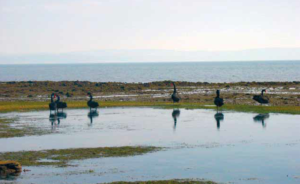
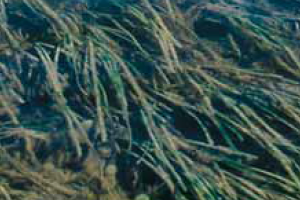


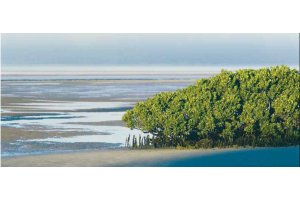
- Tour 4 – Victorian forested catchments (North of Melbourne)
More than 3 million hectares of Victoria’s public forest are managed to balance different societal requirements, including sustainable timed production, protecting water quality and conserving native biodiversity.
Delegates will get an opportunity to see a number of native tree species unique to Victorian high rainfall environments including mature as well as younger regenerating forests.
The tour will visit the Toolangi State Forest to the north of Melbourne. At the first stop an overview of the landscape interactions between agriculture, forestry and recreation in the local catchments will be given. This will be followed by visits to a recently harvested area, to regrowth area from bushfires as well as to a site that was burnt for management in Autumn 2016.
At these sites, the approaches taken to manage native forests for biodiversity, such as protecting the endangered Leadbeater’s possum, as well as active fire management will be presented.
After lunch delegates will get the opportunity to take the Wirrawilla Rainforest Walk through Cool Temperate Rainforest and view Large Old-Growth Mountain Ash.

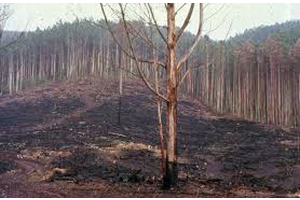

- Tour 5 – Management of Urban Waste (West of Melbourne)
Waste streams are generated by urban as well as agricultural activities. Delegates will view approaches being taken to manage waste streams to minimise their impacts on the environment and to re-use nutrients. Melbourne’s first treatment facility at Werribee has processed urban waste water since the 1800’s, currently processing about half of the urban waste water generated by Melbourne’s 4 million inhabitants.
The facility has developed strategies to meet CSIRO environmental recommendations to reduce N inputs to Port Phillip Bay by 1000 tonnes per year.
The tour to the Western Treatment Plant will include visits to the network of lagoons, which have been declared wetlands of international importance (Ramsar Wetlands).
After lunch, delegates will travel to a research site where ‘sub-soil manuring’ is being investigated as a means of improving crop production. Sub-soil manuring is the deep placement of manures below the root zone to ameliorate sub-soil constraints. Associated with these tours will be presentations of research investigating Victorian and Australian N footprints.
